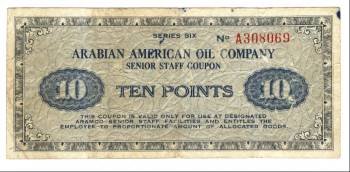|
Donated by Larry Barnes
"Your inquiry about the Aramco bill was forwarded to me for answer. I'll do the best I can.
The picture of the ten-point note brought back memories. I
had forgotten they even existed. To explain them requires me to talk about
the history of money in Saudi Arabia. When I first set foot in the Kingdom, in 1947,
the money in general use was the Indian Rupee. Saudi money consisted of the silver
Riyal, coined in one, half, and quarter denominations. Under that was the qirsh, a
base metal coin. The silver Riyal was the size of a US half dollar with a value of
about $0.29, the same as it is today. There was no paper money. The Saudi government
believed that their people were not sophisticated enough to accept paper. They wanted
coinage with the value in the contents. The SAG (Saudi Arab Government) didn't like
the idea that a foreign currancy dominated their commerce, so they ordered the
company to stop issuing Rupees to its American employees, but the Americans didn't
like the idea of carrying around a ton of silver to go shopping, so the note
you showed us was born. It was good in all Aramco facilities where money changed hands.
Originally,
food in the dining hall was free to bachelor employees. You just came in, sat
down, and ate four steaks if you wished, and I have seen Texas drillers do just that.
But with the advent of more families who were not eligable for mess hall priviledges,
and other foreignors working for Saudi firms in the area, it soon became necessary
to devise some way to keep the outsiders away from the free lunch. Also, many of the
bachelors wanted to do some of their own cooking, so the company started issuing
coupon books to them, consisting of three coupons for each day of the month,
breakfast, lunch, and dinner, with a cash (Riyal) value for each. These coupons could
be used as money in the canteen, snack bars, and retail food store. Local merchants
soon discovered that the Aramco cash office would exchange them for Riyals, so they
became common currancy in the local market as well.
There was a time when the SAG issued gold sovereigns. This was when the US price
for gold was pegged at $35/oz. American housewives would go shopping carrying little
bags of gold. You would think that I would have salted away a bushel basket full of
them, but I didn't. Short pause while I kick myself in the ass. The Saudi sovereign
is worth about $225.00 on eBay.
Finally, the SAG tried an experimant. They had printed a ten Riyal note,
called a pilgrim note. It was for use by foreignors, who were used to paper money,
while making the pilgrimage (the Haj) to Mecca. Much to their surprise, the
Saudis took to them immediately, and they became in high demand. This convinced the
SAG that the time had arrived to go to paper, and the present series of notes was
born.
It is interesting to note that during this time, no one ever turned down a
dollar.
A yarn about what we called the money racket. Aramcons would fequently go
to Bahrain Island on weekends on shopping trips. (Also there were women for rent
over there.) At the time, many goods of interest to Americans were not available in
the local Saudi markets. Bahrain was much better. Here is how the merchants got
their goods. Ships loaded with consumer goods would pull into Bahrain harbor. The
merchants would go out and make their selection for immediate delivery. It was all
cash on the barrelhead, and only dollars were accepted. Where the official rate for
Rupees was 3 1/2 to the dollar, the demand for dollars jumped the rate to six to one
or even higher. Here's how you worked it. An American employee would draw out a sum,
say $100, from the cash office in 20's. He would set sail for Bahrain and trade it
for 600 Rupees or more. Returning to Dhahran, he would replace what he had taken out
in Rupees, say Rs350. That would give him back the hundred dollars he had taken out.
But now he had at least Rs250 in his pocket, just like he had found it on the street.
The profit was the difference between the official rate of exchange and the inflated
rate. Some guys would go over there with big rolls of bills. Th limiting factor was
the amount you could smuggle in through customs. Some executives would order up a
light plane and fly over to Bahrain with several thousand dollars. On return, the
plane would not go through customs because they didn't suspect that the plane had
been out of the country. This only lasted a few months when the company put a halt
to it by not accepting Rupees for deposit. You could still make the Rupee profit,
but there was nothing available to buy with them in any quantity. I once made a
killing by buying two round-trip plane tickets to the States with my Rupee profit.
The airlines didn't do that very long, not even AirIndia. They demanded dollars.
That's about everything I know on the subject, and probably a lot more
than you wanted to know. However, if you have any questions, feel free to email me."
(Larry Barnes) |





